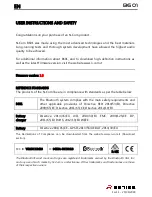
1
Area depth angle adjustment
Depth angle
adjustment screw
: OA-4500S(E)
: Black
: 2.5m(8’2”) to 4.5m(14’9)
: See DETECTION AREA
: Active infrared reflection method
(All presence detection)
: 1st to 3rd rows: -6° to +6°
4th and 5th rows: +26° to +44°
: 12 to 24V AC ±10% (50/60Hz)
12 to 30V DC ±10%
: < 2.5W (< 4VA at AC)
: Green / Stand-by
Red / 1st row detection
Orange / 2nd to 5th rows detects
MANUFACTURER'S STATEMENT
OUTER DIMENSIONS AND PART NAMES
OA-4500S(E)
ENGLISH
ORIGINAL
5918980 201
1.AUG
(1) Connector
(2) Mounting holes
(3) Operation indicator
(4) Depth angle adjustment screw
(5) Width adjustment screws
(6) Dipswitches
(7) Detection window
(8) Area adjustment tool
MANUFACTURER'S STATEMENT
WARNING
Do not wash, disassemble, rebuild or repair the sensor, otherwise
it may cause electric shock or breakdown of the equipment.
Danger of electric shock.
WARNING
CAUTION
NOTE
Disregard of warning may cause the improper operation causing death or serious injury of
a person.
Special attention is required to the section of this symbol.
Disregard of caution may cause the improper operation causing injury of a person or damage to
objects.
NOTE
Read this operation manual carefully before use to ensure proper operation of this product.
Failure to read this operation manual may cause improper operation and may result in serious injury or
death of a person.The meanings of the symbols are as follows.
1. This product is a non-contact switch intended for header mount to use on industrial doors.
Do not use for any other applications.
2. When setting the sensor's detection area, make sure that there is no traffic around the installation site.
3. Before turning the power ON, check the wiring to prevent damage or malfunction of equipment connected to
the product.
4. Only use the product as specified in the operation manual provided.
5. Be sure to install and adjust the sensor in accordance with the local laws and standards of the country in which
the product is installed.
6. Before leaving the installation site make sure that the product is operating properly and instruct the building
owner/operator on proper operation of the door and the product.
7.The product settings can only be changed by an installer or service engineer. When changed, the changed
settings and the date shall be registered in the maintenance logbook accompanying the door.
1
3
2
WARNING
Danger of
electric shock.
Do not use the sensor without the cover.
When using the cable knockout, install the sensor
indoors or use the rain-cover (Separately available)
otherwise electric shock or breakdown of the sensor may occur.
Before starting the procedure, make sure that the power is turned OFF.
When passing the cable through the hole, do not tear the shield
otherwise it may cause electric shock or breakdown of the sensor.
4
Wire the cable to the door controller as shown below.
1.Plug the connector of the sensor.
2.Supply power to the sensor.
3.Adjust the detection area and set the dipswitches. (See
ADJUSTMENTS)
Place the housing cover.
If wiring is to be exposed, break the knockout.
WARNING
Danger of electric shock.
NOTE
NOTE
Make sure to connect the cable correctly to the door controller before turning the power ON.
When turning the power ON or after adjusting the settings, do not enter the detection area for more
than 10 seconds in order to enable the presence detection.
INSTALLATION
The following conditions are not suitable for sensor installation.
-Fog or exhaust emission around the door.
-Wet floor.
-Vibrating header or mounting surface.
-Moving objects or objects that emit light near the detection area.
-Highly reflecting floor or highly reflecting objects around the door.
NOTE
SPECIFICATIONS
45(1 3/4")
63(2 1/2"
)
267(10 1/2")
125(4 15/16")
36(1 7/16")
43(1 11/16")
7(1/4"
)
[mm(inch)]
1 2 3 4
6 7 8
9 10 11 12
14
15
16
13
5
(8)
(1)
(5)
(4)
(6)
(7)
(3)
(2)
Affix the mounting template at the desired
mounting position.
Drill two mounting holes ø3.4mm (ø1/8”) on
the header.
To pass the cable through the header,
drill a wiring hole of ø8mm (ø5/16”).
DETECTION AREA
: Emitting spots
: Emitting spots (Can be eliminated)
1st row
2nd row
3rd row
4th row
5th row
The actual detection area may become smaller depending on the ambient light, the color / material of
the object or the floor as well as the entry speed of the object.
The sensor may not be activated when the entering speed of the object or a person is slower than
50mm / sec. or faster than 1500mm / sec.
NOTE
Make sure that the detection area does not overlap with the door / header, and there is no highly reflecting
object near the detection area otherwise ghosting / signal saturation may occur.
1st to 3rd rows :
4th and 5th rows:
See
ADJUSTMENTS 3-9
for output settings.
Model
Color
Mounting Height
Detection area
Detection method
Depth adjustment
Power supply
Power consumption
Operation indicator
: When 3rd, 4th or 5th row detects.
N.C. / N.O. selectable
50V0.3A MAX.(Resistance load)
: When 1st or 2nd row detects.
N.C. / N.O. selectable
50V0.3A MAX.(Resistance load)
: Approx. 0.5 sec.
: <0.3 sec.
: -20°C to +55°C(-4°F to 131°F)
: <80%
: IP54
: 320g(11.3oz)
: 1 Cable 4m(13’2”)
2 Mounting screws
1 Mounting template
1 Operation manual
1 Area adjustment tool
Activation output
Safety output
Output hold time
Response time
Operation temperature
Operating humidity
IP rate
Weight
Accessories
Activation output
Safety output
The specifications herein are subject to change without prior notice due to improvements.
NOTE
12 to 24V AC (50/60Hz)
12 to 30V DC
: Detection Area
Z
450
(1’6”)
400
(1’4”)
350
(1’2”)
300
(12”)
250
(10”)
Z
A
B
C D
E
F
G
Red
4th and 5th rows
1st to 3rd rows
Blue
Use the area adjustment tool
(B)
as shown below to change the area depth angle for the 4th and 5th rows.
Depth angle adjustment screw
for the 4th and 5throws
Use the area adjustment tool
(A)
as shown below to change the area depth angle for the 1st to 3rd rows.
Use the area adjustment tool
(C)
as shown below to change the area depth angle for all rows.
1-1.Independent adjustment
1-2.Simultaneous adjustments
Shallow
Deep
Shallow
Deep
Shallow
Deep
Deep
2.0
(6’7”)
3.0
(9’10”)
4.0
(13’2”)
4.5
(14’9”)
0
1.0
(3’3”)
1.0
(3’3”)
2.0
(6’7”)
Deep
2.0
(6’7”)
3.0
(9’10”)
4.0
(13’2”)
4.5
(14’9”)
0
1.0
(3’3”)
2.0
(6’7”)
3.0
(9’10”)
4.0
(13’2”)
Shallow
2.0
(6’7”)
3.0
(9’10”)
4.0
(13’2”)
4.5
(14’9”)
0
1.0
(3’3”)
1.0
(3’3”)
2.0
(6’7”)
Deep
Shallow
Depth angle adjustment screw
for the 1st to 3rd rows
Deep
Shallow
Deep
Shallow
Deep
Shallow
Deep
Shallow
2.0
(6’7”)
3.0
(9’10”)
4.0
(13’2”)
4.5
(14’9”)
0
1.0
(3’3”)
1.0
(3’3”)
2.0
(6’7”)
2.0
(6’7”)
3.0
(9’10”)
4.0
(13’2”)
4.5
(14’9”)
0
1.0
(3’3”)
2.0
(6’7”)
3.0
(9’10”)
4.0
(13’2”)
C
Area adjustment tool
A
B
ADJUSTMENTS
Knockout.
[mm(feet,inch)]
[mm(feet,inch)]
[mm(feet,inch)]
2.0
(6’7”)
3.0
(9’10”)
4.0
(13’2”)
4.5
(14’9”)
0
1.0
(3’3”)
2.0
(6’7”)
3.0
(9’10”)
4.0
(13’2”)
[mm(inch)]
Mounting holes
ø3.4mm (ø1/8”)
Wiring hole
ø8mm (ø5/16”)
25(1”)
The lower edge
of the header
50(1 15/16”)
125(4 15/16")
36(1 7/16")
Values of the chart are based on the
following depth angle adjustment settings;




















